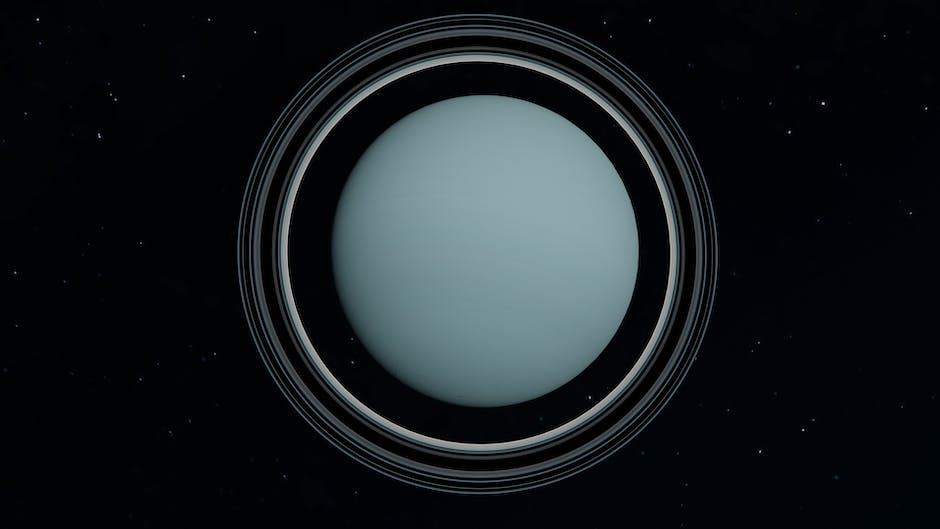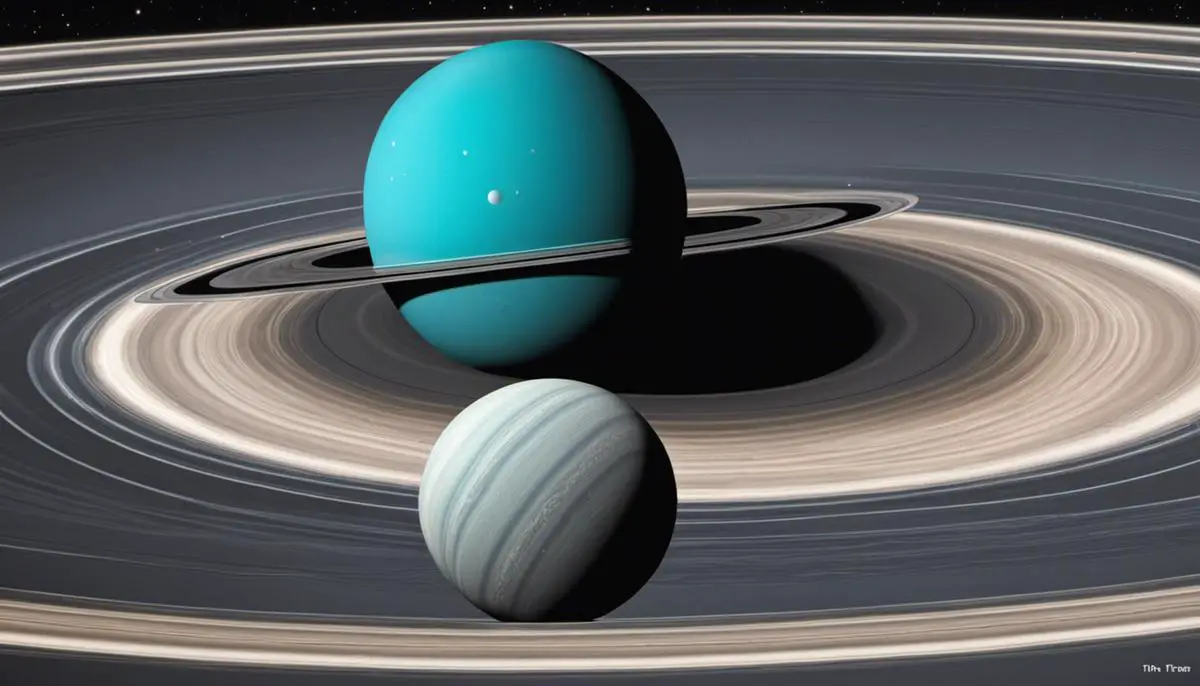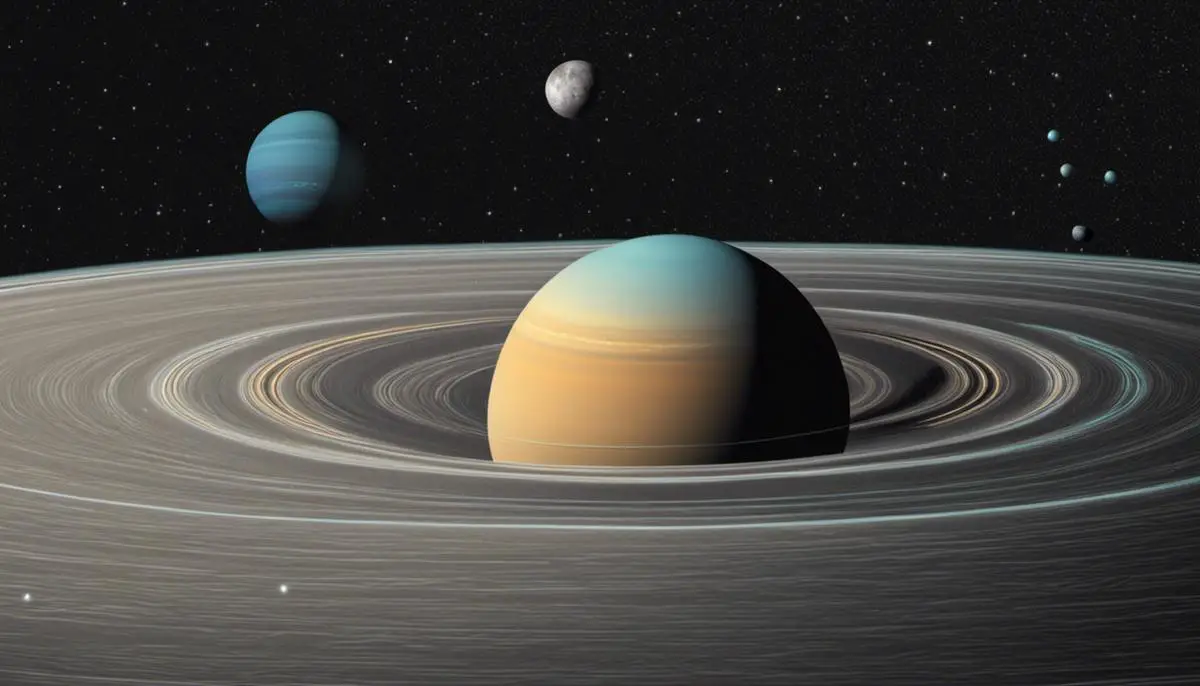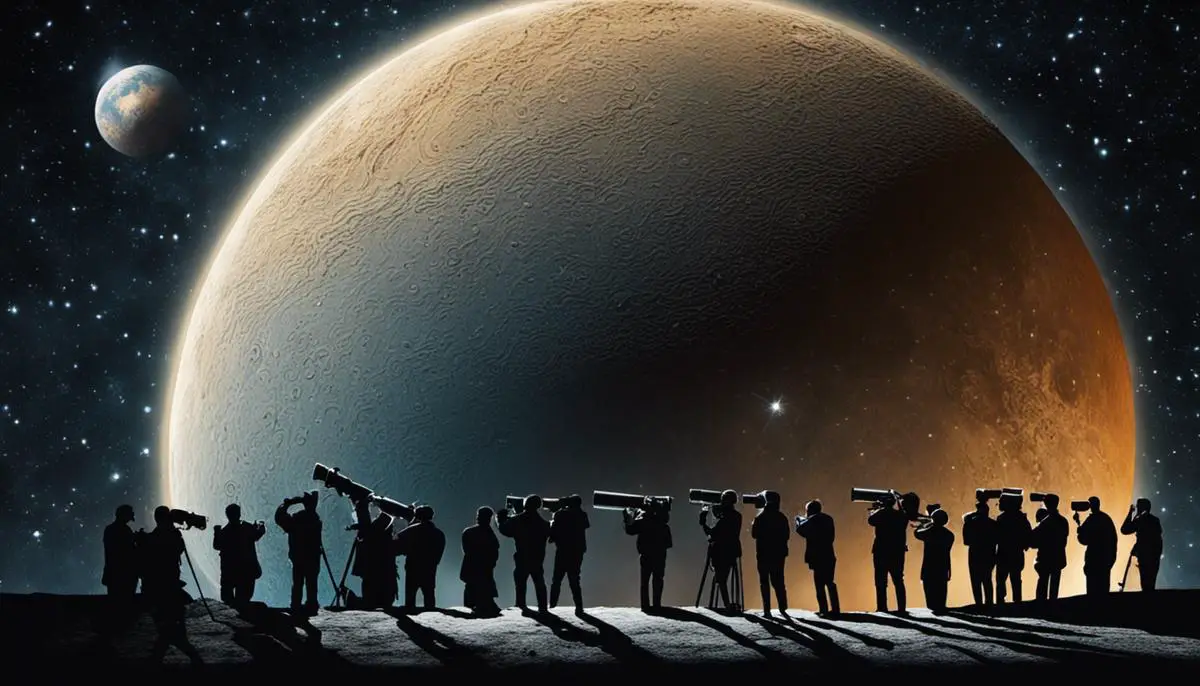Uranus, a celestial body swathed in mystery and frozen at the fringes of our solar system, is a world ripe for exploration and intrigue. This distant planet, first mistaken as a star, holds an air of chilling beauty and has inspired countless studies and debates in the scientific community. Our understanding of this gaseous giant has been brought to life through developments in technology, enabling an in-depth examination of its curious axial tilt, ring system, magnetic field, and its vibrant, icy blue hue. This exploration will delve into the fascinating history of Uranus’ discovery, the challenges faced during its identification, and the novel revelations brought by advancements in space technology.
Discovery and Historical Context of Uranus
An Explorative Journey: The Evolution of Understanding Uranus
Since its initial discovery in 1781 by British astronomer Sir William Herschel, Uranus, the seventh planet from the sun, has incited considerable scientific curiosity and intrigue. Astronomical intellect and technological advancements have facilitated greater comprehension of Uranus’ characteristics, orbital patterns, atmospheric composition, and intriguing moon system, becoming an emblematic testament to the potential of scientific progression and discovery.
First perceived as a static star due to its slow-moving orbit, Herschel’s identification of Uranus as a planet signified a landmark moment in astronomy. It marked the break from the self-induced classical spatial constraints that had gripped the astronomical community for ages, extending our view beyond the six planets recognized since antiquity. The newfound planetary knowledge fundamentally transformed and expanded the boundaries of our Solar System.
Uranus, unlike other celestial bodies, rotates on its side with an axial tilt of around 98 degrees. This implies that its poles, rather than equator, face the sun, leading to prolonged periods of daylight or darkness depending on the position in its orbit. The understanding of this unusual trait, discerned from years of earth-based telescopic observations, is indicative of the sophistication and refinement in observational astronomy over the years.
Uranus, too, has posed an intriguing weather mystery. The planet appears uniform and smooth in visible light, but when observed in infrared light, this ice giant displays deeper, complex atmospherics. The understanding and discovery of this atmospheric disparity emanate from the evolution of spectroscopic advancements, which have allowed the probing of atmospheric components and their movement.
Of significant note is the discovery of Uranus’ moon system, which came to light post its initial discovery, with Ariel and Umbriel found in 1851, and later Titania and Oberon. The discoveries of these moons, made possible through the advancement of telescope magnification, have provided valuable insights into the Uranian system and its composition.
The 1986 Voyager 2 flyby heralded a new chapter in the studying of Uranus. Here, machine-based exploration yielded improved spatial resolution, revealing previously unseen details about the Uranian system. The data from Voyager 2’s instruments presented scientists with an enigma: while Uranus appeared bland at a distance, closer observations revealed a dynamic world buzzing with magnetospheric activity.
The discovery of Uranus serves as a testament to human curiosity, observational acuity, and the advancement of technology. Each new layer of understanding peels back to reveal a more complex universe, challenging our assumptions, and carving out the contours of future exploration. Undoubtedly, as our capacity to observe and explore Uranian intricacies continue to evolve, this enigmatic ice giant will yield further astrophysical phenomena, instigating countless opportunities for scientific ingenuity, exploration, and learning.

Physical Properties of Uranus
Moving forward, an illuminating characteristic is the peculiar temperature and energy distribution within Uranus, that disassociates it from other gas giants within our solar system. In most planets, solar energy absorbed by the atmosphere predominantly drives the weather systems. However, Uranus seems to be devoid of any such solar influence. The reasoning behind this phenomenon traces back to its incredibly flat spectral energy distribution. Unlike other planets, the heat inflow and outflow from Uranus are nearly balanced, leading to a strangely uniform temperature of about –224 degrees Celsius in its atmosphere. This ascertains the unusually faint nature of the bands of clouds in Uranus, again, distinguishing it from every other gas giant.
Further diving into the guts of the planet, the internal structure of Uranus is another revealing facet. Descriptions remain based on theoretical modeling, due to our inability, as of present, to examine Uranus’ interior directly. Predominantly composed of icy materials (water, methane, and ammonia ices) mixed with rock, Uranus’ core contrasts to those of other gas giants in its relative minimalistic size – particularly puny, accounting for merely 0.55 times the mass of Earth. Encasing the core is what is hypothesized to be a mantle, saturated with water, ammonia, and other elements, further enveloped by an atmosphere rich in hydrogen and helium.
The study of Uranus also brings into account a feature that resonates its vertebral uniqueness – the formidable ring system. The η ring, one among the 13 recognized rings of Uranus, is noteworthy for its blue color – a stark variant from the grey rings identifiable around Uranus – possibly accredited to the minute size of its constituent particles. Unlike the spectacular, copious rings of Saturn, the rings of Uranus, essentially unglamorous in their understated existence, again, set the planet apart.
Further augmenting Uranus’ unprecedented singularity is its bizarre plasma environment. The interaction between Uranus’s peculiar magnetic field and the solar wind results in puzzling dynamics. Counter to expectations based on other planets, the solar wind is not the primary source of plasma around Uranus. Instead, the major contributors are the planet’s ionosphere and the Enceladus-type moon, Ariel. The ensuing spatial plasma asymmetries further advance the case for Uranus’ distinctiveness.
This compelling journey through the physical properties of Uranus has, undoubtedly, unveiled the planet’s uncanny features and profound uncommonness, setting it apart from its celestial kin within our solar system. The underpinning science delineates that even in the field of planetary science, where universal laws and norms dictate the workings of celestial bodies, scope for anomalies persist – Uranus being a glaring example. What’s more, it holds the potential to reshape our understanding, leading us to unforeseen routes and revelations in the realm of cosmic exploration.

Uranus’ Atmospheric Composition
As the seventh planet from the sun in our solar system, Uranus poses unique challenges and opportunities for scientific inquiry. Its distinctly mixed atmospheric composition, largely comprised by the gases hydrogen (H2), helium (He), and methane (CH4), provides salient clues about the planet’s prevailing climate and weather patterns. This narrative does not stop at merely enumerating the gases found in Uranus’ atmosphere; it dives deeper to elucidate how these elements help paint the broader picture of climatic and meteorological activity on the ice giant.
The overarching structure of Uranus’ atmosphere, compounded by the existence of an intermediate water-ammonia ocean, offers fascinating insights into the planet’s weather phenomena. A thick, bulky atmosphere wraps Uranius under a blanket of hydrogen and helium, among others. Rising concentrations of methane essentially absorb red light, lending the planet its iconic bluish hue. Involved sub-analysis of this atmospheric recipe, nevertheless, unlocks a different question: How does the blend of gases induce the planet’s peculiar weather?
A significant aspect of Uranus’ weather is the planet’s consistency in temperature. Uranus remains relatively uniform in temperature, with faint clouds lingering around -350 degrees Fahrenheit—frigid compared to Earth standards. The seemingly uniform temperature across the planet appears to counter the science of conventional understanding. This is largely attributed to the interaction between the planet’s abundance of helium, hydrogen, and the lack of solar involvement in driving Uranus’ weather.
Indeed, the sun, nearly 2 billion miles away, contributes minimally to Uranian weather patterns, a drastic departure from terrestrial atmospheric dynamics. Uranus, instead, is largely self-sufficient—with the movement and interaction of gases within the planet’s dense atmosphere playing a substantial role in driving weather systems.
A cogent reading into Uranus’ atmosphere and climatic pattern further helps build our understanding of the planet’s internal structure. Comprising a multitude of icy materials – water/ice, ammonia, and methane, amongst others – its internal structure seemingly harmonizes with its enigmatic atmospheric profile, with the ices likely a determinant factor in its peculiar weather patterns.
Stunningly, despite Uranus’ initially bland appearance, the careful interplay of its atmospheric gases – coupled with an unusual rotational axis – causes dramatic and beautiful weather phenomena. Landmark observations have noted vibrant, colorful storms and faint, almost spectral, cloud tracks unmapped in other parts of our solar system, further enhancing its uniqueness in terms of climatic and meteorological conduct.
Moreover, Uranus’ faint but distinct ring system, especially the blue-colored η ring, provides additional clues on the planet’s weather. Its plasma environment, shaped by its magnetic field and solar wind, also frames its whimsical weather patterns.
The allure of Uranus weather intricacies undeniably stems from its disparity comparative to other celestial bodies. Its unusual atmospheric conduct, alongside its unique characteristics, holds transformative potential in refining our understanding, encouraging us to develop novel methods, routes, and technologies for cosmic exploration.

Uranus’ Moons and Rings
Pivoting from atmospheric and internal structures, let’s delve into the distinguishing features of Uranus’s moons and ring system.
Scientific examination of this ice giant’s intriguing satellites has been a source of fascination, with each moon’s peculiarities adding to the tapestry of knowledge in planetary science.
Spanning 27 in count – each moon of Uranus provides a unique observational field. Five of these are larger moons, namely, Miranda, Ariel, Umbriel, Titania, and Oberon. Among them, Miranda harbors a chaotic terrain, leading to the theory of an intense geological past, possibly due to tidal heating. Moreover, the presence of fractal patterns across Ariel’s surface heavily implies geologically active periods in its history.
Contrary to popular belief about natural satellites, Uranus’s moons are not similar to our Moon; instead, they are constructed mostly of ice, with a mix of rock. This composition, with an admixture of dark carbon substances, contributes to their relatively low albedo – the measure of reflectivity – consequently making them some of the darkest objects in our solar system.
The most mesmerizing aspect of Uranus, however, is imprinted in its complex system of rings. Thirteen distinct rings curve around the planet, intriguingly not visible through ordinary telescopes. This invisibility is attributed to their dark composition – composed of small particles ranging from pebbles to tiny boulders, infused with organic materials.
An intriguing note on Uranus’s rings lies in their unique color. The outermost ring, known as the ε ring, cues blue, while the inner rings portray a reddish tint. This variation in hue demonstrates the possible different compositional materials in the rings, with the ε ring most likely composed of minute icy particles akin to Saturn’s outermost ring.
Under the influence of the solar wind and Uranus’s magnetic field, the moons and ring system shape the planet’s intricate plasma environment. The moons act as obstacles to plasma flow, becoming immersed in the magnetosphere of Uranus and interacting with the plasma to create dynamic phenomena such as plasma tori and auroras.
There is an evident interconnectedness between the celestial bodies orbiting Uranus and the planet itself. This relationship extends beyond the gravitational interaction to intricate influences on Uranus’s plasma environment. In-depth exploration and understanding of the complex interaction patterns present astounding potential in unfolding the yet unknowns about this planetary system.
In the pursuit of understanding our cosmos, the study of Uranus and its celestial environs symbolizes an intriguing challenge and opportunity. Blending observational astronomy with our growing technological prowess, the mysteries of these distant worlds inch ever closer to discovery. Diving deeper into the nuances of Uranus’s moons and rings not only profoundly impacts our understanding of our solar system’s history, formation, and dynamics but also propels forward the frontier of planetary knowledge and discovery.

Through unveiling the numerous facets of Uranus, from its historical discovery to its physical properties and atmospheric composition, we can gain a richer understanding of this delicate and complex celestial system. Diving into the intricate configurations of its moons and rings unravels further layers of its complexity, contributing to our collective knowledge of our solar system and beyond. As we continue to peer into the icy depths of Uranus, with each new observation and discovery we evolve our understanding and challenge the boundaries of human knowledge and exploration. The enthralling story of Uranus is an emblem of the vast potential and infinite mysteries that lay beyond our earthly home, constantly inspiring us to reach for the stars.
![]()
